Information about Delphi Greece
Delphi in Greece was, and still is, renowned for its oracle that draws guests from across the world. Just two and a half hours from Athens, it is conveniently close to such weekend retreats as Arachova, Parnassos and Galaxidi. Visitors are first able to view the ancient city when entering from Arachova, set against the eerie vertical rocks of Phaedriades and surrounded by Pleistos valley’s olive grove towards Krissian field.
Along the central asphalt road stands the sanctuary of Athena Pronaia where an enigmatic Dome and gymnasium exist. One can also experience the Sacred Way – a path pilgrims once took – decorated with Athenians, Megarians, Siphnians and Sikyonians constructions along with many votives. When passing by the rock of the Sibyl and Athenian portico you will come across Apollo’s Temple where Pythia spoke incomprehensible prophecies in a trance-like state.
Further along you’ll find a theatre followed by a 15 minute uphill walk ending at the stadium before reaching the museum that showcases noteworthy works of archaeological research. Although Delphi lies seamlessly connected to its former self, due its mountainous terrain it isn’t visible from there
The archaeological walk ends at the museum, where the most famous finds of archaeological research are presented. The modern city of Delphi extends in continuity with the ancient one, but due to the geographical relief it is not visible from it.
Perched on the southern slopes of Parnassos, it has not preserved any special architectural character, but offers an excellent view of the olive grove of Amfissa and the bay of Itea. Tourist traffic is concentrated on the two main streets , where you will find shops with folkloric tourist items, taverns and modern cafes with a view.
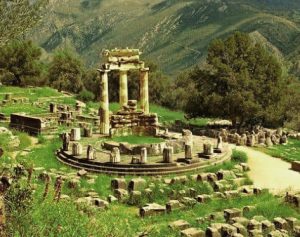 Τhe sanctuary of Delphi in Greece with its famous oracle was founded at the foot of Parnassus, the Holy Mountain of the ancients, in the evocative landscape formed between the two towering rocks of the Phaedriades. Two eagles sent by Zeus from opposite directions to find the center of the world met at Delphi.
Τhe sanctuary of Delphi in Greece with its famous oracle was founded at the foot of Parnassus, the Holy Mountain of the ancients, in the evocative landscape formed between the two towering rocks of the Phaedriades. Two eagles sent by Zeus from opposite directions to find the center of the world met at Delphi.
Since then they have been identified with the “navel of the earth”. For many centuries they were a spiritual and religious center, but also a symbol of the unity of ancient Hellenism. With the institution of the Amphictyones, they gave the motto of friendship and peaceful coexistence, which was the fundamental pursuit of the Delphic Idea.
According to tradition, in the area of Delphi there was originally a sanctuary dedicated to the goddess Earth, guarded by the dragon Python. Apollo, god of light, transformed into a dolphin arrived with the Cretans at Kirra, which was the port of Delphi. After killing Python, he established his own shrine. This myth survived in various celebrations and of course with the famous Pythias which included musical competitions and nude competitions.
The oracle of Delphi flourished between the 6th and 4th centuries. e.g. and his oracles were considered the most reliable. They were expressed by the Pythia who was in ecstasy thanks to the smoke rising from a chasm in the sanctuary of Apollo’s sanctuary. The priesthood transferred them to the interested parties.
Archaeological evidence, testimonies of ancient writers and the science of geology verified the existence of the chasm and the vapors that brought the Pythia into a trance.
However, there were other ways of divination, such as the flight of birds, the examination of entrails, fire, sacrifice, etc.
Ancient pilgrims, including wealthy individuals, rulers, ambassadors of cities, expressed their gratitude for the oracles given to them by flooding the sanctuary of Apollo with offerings of great artistic value.
Delphi was a significant religious and cultural center in ancient Greece and is famous for its Oracle, which was consulted by both Greeks and foreigners seeking advice and prophecies.
The ancient Greeks considered Delphi as the center of the world and believed it to be the dwelling place of Apollo, the god of music, light, and knowledge. The Oracle of Delphi, also known as the Pythia, was believed to possess the ability to communicate with Apollo and provide insights into the future.
Visitors to Delphi Greece, can explore the extensive ruins of the site, which include the Temple of Apollo, where the Oracle resided, as well as the theater, stadium, and numerous treasuries dedicated by various Greek city-states. The site offers a fascinating glimpse into the religious and cultural practices of ancient Greece.
In addition to the archaeological site, Delphi is also a picturesque town located nearby. It offers stunning views of the surrounding landscape and is a popular tourist destination. Visitors can enjoy exploring the narrow streets, visiting local shops and restaurants, and taking in the serene atmosphere.
Delphi is approximately 180 kilometers (112 miles) northwest of Athens and can be reached by car or bus. It is advisable to check the operating hours and any entry restrictions before planning a visit to the archaeological site, as they may vary depending on the season and current circumstances.
The oracle of Delphi in Greece, was one of the most sacred places in the ancient world. Situated in the breathtaking surroundings by the mythical Mount Parnassus, where Pan and the Nymphs lived, it is still an enchanting site. The ancient Greeks believed that Delphi was the centre of the world and in the oracle was foretold the future of kings and common men.
Although Delphi was inextricably linked with Apollo, there was a pre-existing sanctuary of the goddess Earth (Gaia) who was worshiped in the caves of the area, although archaeologists’ research did not discover them. Apollo came later, according to legend, and killed Python, the sacred snake-guardian of Mother Earth, occupying the sanctuary.
The oracle of Delphi during the antiquity could only be consulted once a year, but as its reputation grew more and more pilgrims came, and more days were added to the agenda. During the three months that Apollo was believed to be away, the oracle was silent.
After going through purification rituals and paying a certain tax, the pilgrim that would be allowed to consult the oracle could ask his question to Pythia.
Pythia was a woman from the village Delphi, and in most cases she was a young virgin. We do not know exactly in what state of mind she was, but she was probably under the influence of some sort of narcotic substance. Tradition holds that fumes were coming out of a crack in the ground, but no such crack has been found.
After Pythia had spoken, the priests interpreted her words to the pilgrim. The answers were always vague, and in this way the oracle was almost always right. This gave the priests great political power, and their credibility was discussed even in ancient times. It is said that the fable writer Aesop had called them the “parasites of Apollo” and for this the priests killed him
Mythology
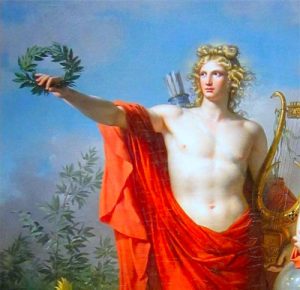 Although Delphi had been dedicated to many deities before him, Gaea, Themis and Phoebe, Apollo is the god most connected to the place. According to mythology, Apollo killed the monster Python who guarded the site and built the first temple here ( Python was a child of the Earth, whom according to tradition she made from the mud of the flood and it had fortune-telling abilities). In any case, since the murder was an innocent act, Apollo was forced by Zeus to tend the sheep of the Trojan king Laomedon, as a punishment, which Apollo fulfilled in full.
Although Delphi had been dedicated to many deities before him, Gaea, Themis and Phoebe, Apollo is the god most connected to the place. According to mythology, Apollo killed the monster Python who guarded the site and built the first temple here ( Python was a child of the Earth, whom according to tradition she made from the mud of the flood and it had fortune-telling abilities). In any case, since the murder was an innocent act, Apollo was forced by Zeus to tend the sheep of the Trojan king Laomedon, as a punishment, which Apollo fulfilled in full.
He then went away to purify himself from the deed, and the Pythean games were held every eight years to commemorate the event. Later, they were held every four years and were mainly musical competitions. The winner was crowned with a wreath of laurel, since the Laurel was Apollo’s special tree.
Delphi had been defined as the canter of the earth by Zeus, who one day let his two eagles fly around the earth and where they met – the centre, Delphi, lay. A stone was put at the point called Omphalos – the Navel – an can still be seen in the museum of Delphi.
Another myth also tells us that it was here the human kind got a second chance. Zeus was sick and tired of humanity, its thievery, lies and treachery, and decided to drown them all in a flood. The good man Deucalion had been warned by his father Prometheus and had built an ark in good time. The flood drowned the earth, but Deucalion and his wife were safe in the ark, and when the water started sinking, they landed on the top of Mt. Parnassos. Deucalion then went to the oracle to ask what to do next, and the oracle told him to throw the earths bones behind him. He then took some stones which he interpreted to be the bones, threw them over his shoulder, and new humans grew out of them.
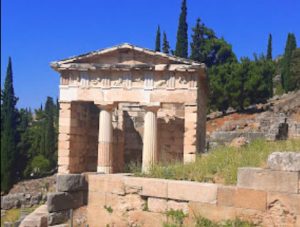 Deucalion had a son with his wife, and he was to be called Hellen (“Greek”). He, in his turn, became the father of three children. Aeolus, Dorus and Xythos, and the grandfather of Ion and Achaios. These sons would all be the ancestors of the Greek tribes.
Deucalion had a son with his wife, and he was to be called Hellen (“Greek”). He, in his turn, became the father of three children. Aeolus, Dorus and Xythos, and the grandfather of Ion and Achaios. These sons would all be the ancestors of the Greek tribes.
Heracles had also come to Delphi, but with a wicked purpose: he wanted to steal the tripod Pythia sat on. He failed, but still a temple was built in Heracles’ honour.
Finally Dionysus also had to do with Delphi. He ruled here in Apollo place during the three months the latter was away in the north. Then chaos ruled here, with enraged women, the maenads, tearing wild animals to pieces and everyone in a constant state of drunkenness.
Another mythological tradition wants Apollo to have come down to Greece from the country of the Hyperboreans; although we cannot be sure, it is probably Scandinavia or the Baltic countries. Apollo returned to this country every winter and with the coming of spring he descended to Delphi on a chariot drawn by swans, his sacred animals. As for his sacred plant, it was none other than the laurel. Daphne was a nymph, whom Apollo fell in love with and relentlessly pursued. To escape from him, shortly before he captured her, she transformed into the plant of the same name.
History of Delphi
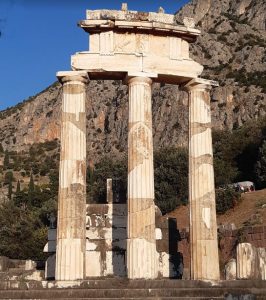 Delphi is mentioned by Homer, who calls it Pytho. There is evidence that there was a cult here in the Mycenaean period.
Delphi is mentioned by Homer, who calls it Pytho. There is evidence that there was a cult here in the Mycenaean period.
A temple dedicated to God Apollo stood here in the 8th century BC, if not before. In the 7th century BC the area was already quite full of buildings and statues. In the 6th century BC a big sphinx was made out of marble from Naxos and put here, as well as treasure houses for Athens, Sicyon and Knidos.
It was also now that Delphi had been liberated from the Krisan state, and thus became autonomous. The games and the sanctuary was from then on organised and controlled by the 12 citystates that had formed the Amphictyonic League.
In 528 a terrible fire destroyed the old temple of Apollo. Almost all Greek city-states helped to rebuild it, and in 505 a magnificent new temple stood here.
In the following century the Sifnian treasure house was built, and after the battle of Marathon Athens also built a new one.
In 373 BC an earthquake destroyed much of Delphi, including the Apollo temple. Soon, s new collection began among the city states, and in 329 BC it was finished. Here, the famous inscriptions “Know yourself”, “Keep the measure” and “E” were made. Pythia sat here and told the future through an incomprehensible mumble that was then interpreted by the priests.
This is also where the omphalos, the navel stone, stood as well as Dionysus’ tomb.
The theatre was built, but it was during the next century that it was rebuilt of stone by Eumenes II of Pergamon so that the audience would actually have seats, and not just sat on the slopes. It could hold 5000 spectators.
In 390 AD the oracle was shut down by emperor Theodosius. In 1892 French archaeologists started excavating the are, after the ancient village Kastri, that was built on top of it, had been moved.
The oracles in Ancient Greece
The need to predict the future is a human need as primordial as human civilization itself. The fear of what the future holds and the desire to control it has driven many people to this day to turn to all sorts of experts and charmers to exorcise evil.
Despite the progress of science, the hope of prediction has not abandoned even the smartest and strongest people. In ancient times, fortune-telling was considered a divine gift and fortune-tellers were propitiators. Gradually, divination began to work in sacred areas, dedicated to the gods. Greece was no exception.
All these myths were sculpted during the Dark Ages, immediately after the collapse of the Mycenaean kingdoms. Apollo was a foreign god, unknown to the Mycenaeans. It is most likely that he was adopted from the East, which is why Homer wants him to be a friend of the Trojans. His sanctuary exists in Patara in Lycia, while his mother’s name has roots in the Lycian language: Leto (lada) in this language means woman.
When his cult spread to Greece, he replaced older cults, such as that of Mother Earth and incorporated elements from her rituals, such as the female priestesses: while in the other sanctuaries of Apollo the soothsayers were men, in Delphi the priestess who expresses the words of the god is a woman, Pythia, who took her name from Python. This integration is on the one hand an “opening” to the believers of the old religion and on the other an attempt to make Apollo appear as a continuation of an ancient cult, competing with Dodoni.
The oracle of Delphi emerged as a pan-Hellenic sanctuary at the time of colonization. Colonization, among other things, was also a religious issue. Sanctuaries had to be established in the colony, worship had to be established, therefore the blessing of the god was required. The Greek colonies had independence from their metropolises, but religious ties were very close. The leader of the colonists, the settler carried the flame from the sanctuary of the metropolis and was responsible, among other things, for religious matters.
Pythia answered questions about where and how to establish a colony. The answer was such that you had to look for its meaning. Sometimes a city asked, sometimes a private person. When Wattus of Thera consulted the oracle what to do about his stuttering, the Pythia replied that he should establish a colony in Libya: Wattus became the settler of Cyrene, the largest colony in Africa and the founder of the Wattiad dynasty in town.
Most of the time, the oracle had enough information about the places being colonized. Most likely, he had an intelligence network of traders, sailors and former settlers. Thus, the advice was usually sound, not only about where the settlers should go, but also where not to go: the Spartan Dorias, angry, having lost the throne of Sparta to his half-brother, Cleomenes, in 519 BC. , decided to leave the city and establish a colony in Libya, but without consulting the oracle of Delphi, as was traditionally done. He founded Kinypa, near today’s Tripoli, much further west than Cyrene. The Carthaginians, feeling threatened, attacked and destroyed the colony just 3 years after its founding.
The oracle’s fame spread outside of Greece. Foreign rulers such as Midas of Phrygia (known for his donkey ears), Gyges and Croesus of Lydia sought his advice and filled it with gold. Croesus, fearing the expansion of the Persians and wanting to test the effectiveness of the oracles, sent emissaries simultaneously in several divinations, asking if they know what he himself did on the hundredth day after their departure.
Only Pythia answered correctly, so Croesus sent gifts of insurmountable beauty. When asked if he would prevail against Cyrus’ Persians, the Pythia replied that “if he attacks, a great empire will be destroyed.” Croesus attacked in 546 BC, lost the battle and his kingdom. Ambiguously told, the oracle shows the oracle’s intelligence to carefully answer the rulers.
In addition to foreign rulers, Greek tyrants also consulted the oracle. He supported the rise and maintenance of tyrants in power, seeing that they were not originally hated by the people. Many tyrants, such as Cypselos of Corinth, dedicated many gifts to the oracle to gain his favor. It is most likely that the oracle did not support the tyrants out of ideology, but out of political flexibility; sometimes, of course, it was asked to favor a change of polity, such as in Sparta (reform of the Great Clause) and in Athens (Solon’s legislation).
Scientists have tried to decipher the place and the ceremony of giving money. Geologists certified that there was no gap in the interior of the temple from which smoke could emerge. However, as the sanctuary has been built in the hollows of the rocks of Parnassus, it is very possible that there were openings, caves under the floor of the temple, where Pythia descended.
However, whatever the truth is about the divine gift of the Delphic oracles, their history is centuries old and does not fit into a few pages. Whether divinely inspired or not, the oracle people held it prominently for many centuries, demonstrating their political sensibility,their acuity and insight. Many traditions about the Delphic oracles are after the fact, made up to either cover up the oracle’s mistakes or emphasize its contribution to the great events of the time.
After all, as a saying goes “and God wants advertising, that’s why the bells ring”. None of this negates the truly enormous contribution of the oracle to the history and culture of ancient Greece. It was a political stake for the Greeks, so that 4 holy wars were fought because of it. It was a timeless institution together with its biggest competitor, the oracle of Dodona.
What to see in Delphi
The archaeological museum of Delphi
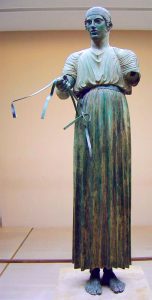 The archaeological museum of Delphi presents the history of the famous Delphic sanctuary and the most famous oracle of the ancient Greek world.
The archaeological museum of Delphi presents the history of the famous Delphic sanctuary and the most famous oracle of the ancient Greek world.
Its rich collections mainly include architectural sculptures, statues and works of micro-art, dedications of the faithful to the sanctuary, which reflect its religious-political and artistic activity throughout its historical course, from the foundation of the Apollonian sanctuary in the 8th century. e.g. until its decline in the years of late antiquity.
All the rooms are of incomparable importance, starting of course from the vestibule, where the Delphic symbol as the center of the world – the Omphalos – which was in the sanctuary of the temple of Apollo, is exhibited, and ending in the twelfth room with the imposing statue of the Chariot
Gymnasium of Delphi
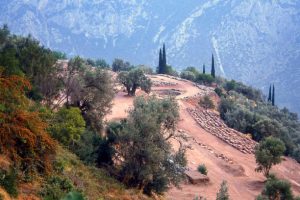 One of the most complete complexes of antiquity, which included a gymnasium and bathing facilities. It is located on the slope between the Castalia fountain and the mosque of Athena Pronaia. Initially it was used exclusively for the training of athletes, but in the Hellenistic era orators, philosophers and poets gave lectures here.
One of the most complete complexes of antiquity, which included a gymnasium and bathing facilities. It is located on the slope between the Castalia fountain and the mosque of Athena Pronaia. Initially it was used exclusively for the training of athletes, but in the Hellenistic era orators, philosophers and poets gave lectures here.
The Gymnasium was dedicated to the exercise of the body as well as the spirit of the athletic youth of the classical era. It operated from the 4th c. e.g. But we know from the foundations of earlier buildings, that the area was already used from the 6th century. e.g. According to the traveler Pausanias, Odysseus was injured by a wild boar while hunting with the sons of the hero Autolycus at the Delphi Gymnasium.
The buildings of the 4th c. e.g. they develop in two longitudinal planes. The lower level housed the Palestra, where athletes practiced wrestling and boxing. It consists of a square central courtyard surrounded by arcades with a perimeter colonnade. Around the perimeter of the palaestra would also be the bowling alley for the training of the boxers and perhaps a sanctuary of Herakles. In the middle of the 18th century, a Byzantine monastery dedicated to the Virgin Mary was built on the site of Palestra.
To the west of Palestra is the circular swimming pool, the most well-preserved example of the classical period. There the young people would cool off after the sport, after first washing with the cold water of the Castilian spring collected in ten stone tanks. The upper level of the Gymnasium was intended for the practice of the young people in the street competition. It includes the scraped road, an elongated covered portico, and the side street, an outdoor space parallel to the portico. The length of both routes is estimated at 178.35 m, i.e. the length of a Pythian stage, while their width was 7 m.
Ancient theater of Delphi
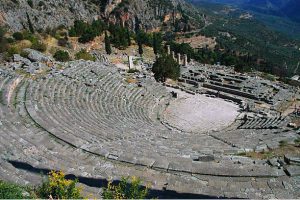 It is located in the archaeological site of Delphi and was the center of the second most important pan-Hellenic games, the Pythians which emphasized the arts of Apollo (drama, poetry, music).
It is located in the archaeological site of Delphi and was the center of the second most important pan-Hellenic games, the Pythians which emphasized the arts of Apollo (drama, poetry, music).
It is made of Parnassos stones (grey) and has a diameter of 52.5 meters. It is divided into two zones. The upper one has 8 rows of figurines and is divided into seven stands. The lower one has 27 rows of figurines and is divided into 6 stands. The total capacity of the theater is 5,000 spectators.
Its construction began in the 4th century BC. Its current form was completed in 160/159 BC. (early Roman times), funded by Eumenes II of Pergamum.
Ancient stadium of Delphi
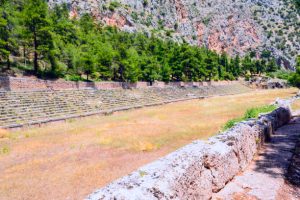 At the highest point of the ancient city, above the sanctuary of Apollo, it is one of the best preserved monuments of its kind. Its original configuration dates back to the 5th century. BC, but it acquired monumental stone benches only in the 2nd century. AD, thanks to a donation by Herodes Atticus. The stadium is mainly identified with the Pythian Games, one of the most important sporting events of antiquity.
At the highest point of the ancient city, above the sanctuary of Apollo, it is one of the best preserved monuments of its kind. Its original configuration dates back to the 5th century. BC, but it acquired monumental stone benches only in the 2nd century. AD, thanks to a donation by Herodes Atticus. The stadium is mainly identified with the Pythian Games, one of the most important sporting events of antiquity.
The stadium is situated on the slopes of Mount Parnassus, overlooking the sanctuary of Apollo at Delphi. It was strategically placed to take advantage of the natural terrain, providing spectators with a panoramic view of the games.
Construction: The stadium was built around the 5th century BCE and underwent several renovations and expansions over the centuries. It was initially constructed entirely of natural stone and later reinforced with additional seating areas.
Design: The stadium followed a typical Greek stadium design, with a long and narrow rectangular shape. The track was around 177 meters (581 feet) long and 25 meters (82 feet) wide, with a U-shaped embankment on one side serving as seating for the spectators.
Capacity: The stadium could accommodate approximately 7,000 to 7,500 spectators, although it is important to note that ancient stadiums did not have fixed seating as we do today. Instead, spectators would sit on the grassy embankments or bring their own portable seats.
Track and Field Events: The stadium hosted various track and field events during the Pythian Games, including foot races, wrestling, long jump, discus throw, and javelin throw. The Pythian Games were held every four years in honor of Apollo and attracted athletes from across ancient Greece.
Connection to Oracle: The stadium was closely associated with the Oracle of Delphi, the famous priestess who delivered prophecies and advice from the gods. The athletes who competed in the Pythian Games would often visit the Oracle to seek her blessings before their events.
Modern Excavation: The stadium was partially excavated in the 19th century by the French Archaeological School at Athens. Today, visitors to the archaeological site of Delphi can explore the remains of the stadium and imagine the ancient sporting events that once took place there.
The ancient stadium of Delphi stands as a testament to the rich history and cultural significance of ancient Greek athletics and the prestigious Pythian Games.
European Cultural Center of Delphi
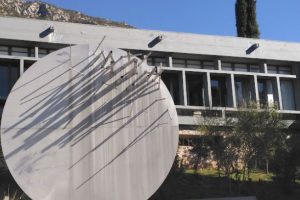 West of the modern city, in a pine-covered area, overlooking the Corinthian, it hosts in its facilities educational programs, conferences and exhibitions and in the summer artistic meetings in an open-air theater with 1,100 seats. Sculptures by important artists are presented in a permanent exhibition in the surrounding garden.
West of the modern city, in a pine-covered area, overlooking the Corinthian, it hosts in its facilities educational programs, conferences and exhibitions and in the summer artistic meetings in an open-air theater with 1,100 seats. Sculptures by important artists are presented in a permanent exhibition in the surrounding garden.
The European Cultural Center of Delphi aims to promote and preserve European cultural heritage and foster cultural exchange and dialogue among European nations. It serves as a platform for various cultural activities, including exhibitions, conferences, workshops, and performances, focusing on art, history, philosophy, literature, and other disciplines.
The center hosts numerous events throughout the year, bringing together artists, scholars, and intellectuals from different European countries. It provides a space for interdisciplinary discussions, presentations, and collaborations, fostering a deeper understanding of European culture and its diverse traditions.
In addition to its cultural programs, the European Cultural Center of Delphi also operates as a research institution, conducting studies and publishing works related to European culture and history. It plays an important role in promoting cultural diversity, intercultural dialogue, and European unity.
Visitors to the European Cultural Center of Delphi can explore its exhibitions, attend lectures and performances, and participate in various cultural activities. The center is located in a picturesque setting near the ancient ruins of Delphi, offering visitors a unique blend of history, culture, and natural beauty.
Museum of Delphic Festivals
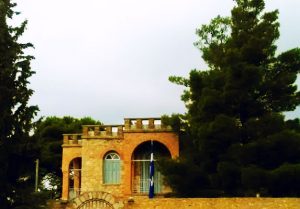 The Museum of Delphic Festivals is housed in the old two-story house of Ανγελοσ Sikelianos in Delphi. The building is located in an extremely privileged position, next to the archaeological site, overlooking Parnassos, the Amfissa valley and the sea.
The Museum of Delphic Festivals is housed in the old two-story house of Ανγελοσ Sikelianos in Delphi. The building is located in an extremely privileged position, next to the archaeological site, overlooking Parnassos, the Amfissa valley and the sea.
It was built in the period 1924-1926 by local craftsmen and under the supervision of Eva Sikelianou. Its architectural features, the carved stonework, arched openings, and fluted columns, recall the neo-Gothic houses in Bar Harbor, where the young Eva spent her summers.
Angelos Sikelianos lived intermittently in the house of Delphi in the years 1926-1933. This page of his life closes definitively with Eva’s departure for America in 1933. Since then Sikelianos will never visit the house of Delphi, neither alone nor with his second wife, Anna Sikelianos. The poet’s desk, his armchair by the fireplace and a walking stick are on display today at the Museum of Delphic Festivals.
The famous loom of Eva Sikelianou, donated by Anna Sikelianou, is exhibited in the ground floor hall of the Museum of Delphic Festivals. In the same space there is a display case with clothes for everyday use that she wove and wore herself, always in the style of ancient Greek clothing.
In the ground floor hall of the Museum is the piano of Eva Sikelianou, a Grunert brand piano with a piano mechanism with a paper music roll (music roll) in the special recess. After Eva left for America and left the house of Delphi, she was guarded for a number of years by Alex. Colombotso, foreman of the house of the Sicilians at Delphi. In 1992 it found its place in the Museum of Delphic Festivals.
In the 60s, the house of the Sicilians was expropriated in favor of the EOT. In 1985, the European Cultural Center of Delphi undertakes its restoration to its original form.
On July 12, 1991, the official opening of the Museum of Delphic Festivals takes place, which operates under the supervision of the Delphi Center until 2011. After the return of the building from the European Cultural Center of Delphi to EOT, the house of the Sicilians is granted to the Municipality of Delphi. The Delphi Center lent items from its collection to the Municipality so that the space could reopen as the Museum of Delphic Holidays, now under the supervision and responsibility of the Municipality of Delphi.
Castalian Spring of Delphi
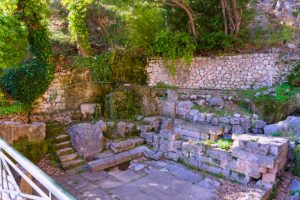 Castalia spring originates from ancient times. It was dedicated to the god Apollo, and according to mythology, it got its name from the nymph who drowned in its waters, to avoid the god of the Sun.
Castalia spring originates from ancient times. It was dedicated to the god Apollo, and according to mythology, it got its name from the nymph who drowned in its waters, to avoid the god of the Sun.
It is located in the eastern part of the Freiadriades gorge and ends in the valley of Pleistos, where the nest of the oracle patron, Python, was located. Python protected the spring and the oracle and tried to prevent the birth of Apollo. But he did not succeed, and the god Apollo took revenge on him four days after his birth. He killed him with arrows of Hephaestus and kept his bones in the oracle of Delphi.
A total of two fountains were discovered in the area of Delphi. The first dates back to 600-590 BC. and the second, which is preserved in better condition, in the 1st c. e.g. The oldest was located near the Sanctuary of Apollo, it had a rectangular shape and bronze lion’s head taps. The newer fountain was larger and is located nearby, 50 meters higher than the old one.
It was carved into the rock and around it there were niches for the faithful to hang their vows. It had a total of seven bronze faucets and a paved courtyard surrounds it. During the period of the Roman Empire the fountains were reformed by the Romans.
Day trips from Delphy
Arachova
One of the favorite winter resorts of the Athenians, it spreads amphitheatrically at the southern ends of Parnassos, at an altitude of 900-1,000 m. Stone houses, cobblestones and the church of St. George at the top of the town create a picturesque setting, which is complemented in modern terms by the trendy cafe-bars and shops on the main street.
Galaxidi
A puppet port, like an island, it preserves the memories of its former glory in the beautiful captains’ houses, the Maritime Museum and its two large churches (Ai-Nicolas, with its ornate wood-carved iconostasis, and Agia Paraskevi). Walk between the mansions and go down the beach to the pine grove Pera Panda.
Gravia Town
Crossing on the Amfissa-Lamia road, in the plain that opens between Parnassos, Oiti and Kallidromos. In the historic battle that took place in its – restored and visitable – inn, on 8/5/1821, Androutsos and the other captains of the area repelled the forces of Omer Vryonis. Itea The quiet seaside town that gazes out from Delphi on the banks of the Corinthian has a large waterfront perfect for walks, coffee and seafood in the sun.
Prophet Ilias Monastery
Between Christ and Delphi, at a point overlooking the olive grove, is the historical starting point of the Revolution of 21 in Roumeli. Interesting is the wood-carved iconostasis of her church, crafted by the Metsovite sculptor Anastasios Moschos. Osiou Louka Monastery The best preserved monastery complex of the Middle Byzantine period in Greece, on the slopes of Helikon, in Steiri Boiotia.
The oldest church is dedicated to the Virgin Mary and dates back to the second half of the 10th century, while the catholicon was built in the first decades of the 11th century. in the style of continental octagonal temples and is adorned with impressive marble and mosaics. Path E4 The European path E4 also passes through Delphi.
Korykeion cave
Following the ancient, signposted route from the Stadium to the National Park of Parnassos you arrive in two and a half hours at the Korykeion cave, the cave where, according to Pausanias, it was dedicated to the worship of Pan and the Nymphs. The view to the sea is unique.
Polydrosos
A developing tourist village between the sources of Boeotian Kifissos and the “feet” of Parnassos. The square with the rustic taverns is a classic meeting point. At a distance of 2 km to the west is the Byzantine cruciform church of Paleopanagia (otherwise known as Mavromandila or Agia Eleousa), the springs and ruins of an ancient sanctuary.
Parnassos Ski Center
At an altitude of 1,600-2,250 m, the largest ski center in Greece spreads out, with 19 pistes, 7 ski routes, 10 paths and three mini pistes for beginners, with a total length of approximately 36 km. Meeting point for skiers and visitors the two chalets in locations Kelaria and Fterolakka. Another smaller ski center operates at Gerontovrachos.
Chryso
Amphitheatrically spread out in the foothills of Parnassos, between Delphi and Itea, the traditional village with its stone houses and old neoclassical buildings offers quiet walks with the olive grove and the Corinthian in the background.
